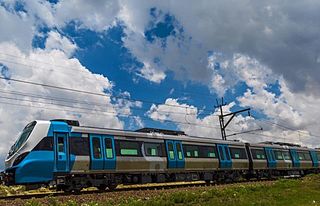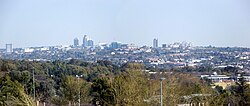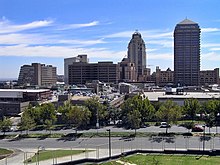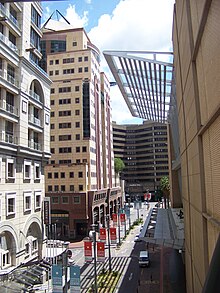
Randburg is an area located in the Gauteng province of South Africa. Formerly a separate municipality, its administration devolved to the newly created City of Johannesburg Metropolitan Municipality, along with neighbouring Sandton and Roodepoort, in the late 1990s. During the transitional period of 1996–2000, Randburg was part of the Northern Metropolitan Local Council (MLC).

Sandton City is a large shopping centre situated in Sandton, Johannesburg, South Africa. It was built and owned by property development company Rapp and Maister, in partnership with brothers Hilliard and Eli Leibowitz, and was later taken over by Liberty Life.
The area referred to as Fourways is the fastest-developing commercial and residential hub in Sandton, north of Johannesburg, South Africa. The main access routes to Fourways are off the N1 at R511 Winnie Mandela Drive, or alternatively along R564 Witkoppen Road. It is located mostly in Region E of the City of Johannesburg Metropolitan Municipality. It is roughly as far as one can go in the Johannesburg Metropolitan area before it dissolves into rolling hills, game farms and the capital Pretoria, 55 kilometres to the northeast. Hartebeespoort Dam and the Magaliesberg Mountains lie half an hour to the north-west. It is bordered by Bryanston to the east and south and Randburg to the west.

The Western Bypass is a section of the N1 and the Johannesburg Ring Road located in the city of Johannesburg, South Africa. Known at the time as the Concrete Highway, the freeway was initially opened in 1975 as a route to avoid the city centre of Johannesburg and to provide access to the western areas of the Witwatersrand. From the south, the Western Bypass begins at the Diepkloof Interchange in Soweto, where it splits from the N12 freeway and ends at the Buccleuch Interchange, where it merges with the N3 Eastern Bypass, M1 South and N1 Ben Schoeman freeways.

Bryanston, Gauteng is an affluent residential suburb of Sandton, South Africa north of Johannesburg. First named as an area in 1949, it was established in 1969 as a suburb of Sandton and provided with tarred roads and municipal services, but after municipal boundaries were revised following the end of Apartheid, Sandton was merged with Johannesburg to form part of the City of Johannesburg Metropolitan Municipality. The multi-lane N1 Western Johannesburg Bypass freeway forms its northern boundary with access at William Nicol offramp. It is located in Region E of the City of Johannesburg Metropolitan Municipality.

The suburbs of Johannesburg are officially demarcated areas within the City of Johannesburg Metropolitan Municipality, South Africa. As in other Commonwealth countries, the term suburb refers to a "neighbourhood", although in South Africa most "suburbs" have legally recognised borders and often separate postal codes. The municipal functions for the area, such as municipal policing and social services, are still managed by the city government.

Kempton Park is a city in the East Rand region of Gauteng province, South Africa. It is part of the City of Ekurhuleni Metropolitan Municipality. It is situated south of Tembisa, one of the largest townships in South Africa, which is also part of Ekurhuleni. South Africa's busiest airport, O. R. Tambo International Airport is located in Kempton Park.
Randpark is a suburb of the city of Johannesburg, South Africa. It is located in the northern suburbs of the City of Johannesburg.
Rivonia is a suburb of Johannesburg, South Africa in the Sandton area. It is located in Region E of the City of Johannesburg Metropolitan Municipality. Rivonia is one of the most affluent residential and business suburbs of Johannesburg, and regarded as the hub of upstart and established I.T. companies. The main retail thoroughfare in the area, Rivonia Boulevard, is the location of several shopping complexes as well as many other shops and restaurants. The area known as Rivonia includes the original township of Edenburg, Edenburg Extension 1, and 19 smaller extensions designated 'Rivonia Extension ...', numbered from 0 to 25. There is no designated township called Rivonia. The post code for Rivonia is 2128.
Sandown is an affluent suburb of Johannesburg, South Africa, in Sandton. It is located in Region E of the City of Johannesburg Metropolitan Municipality. Sandown is both a residential and commercial area and is home to the offices of many major national and international corporations as well as the Johannesburg Stock Exchange in the area known as Sandton Central. The Gautrain rapid rail system's Sandton Station is located in Sandown, linking Sandton to O.R. Tambo International Airport, Johannesburg Central and the Capital City, Pretoria.

Liliesleaf Farm, also spelt Lilliesleaf and also known simply as Liliesleaf, is a location in northern Johannesburg, South Africa, which is most noted for its use as a safe house for African National Congress (ANC) activists during the apartheid years in the 1960s. In 1963, the South African police raided the farm, arresting more than a dozen ANC leaders and activists, who were then tried and prosecuted during the Rivonia Trial.

Sandton is a metro station on the Gautrain rapid transit system in Sandton, Johannesburg. It opened to traffic on 8 June 2010 with service to OR Tambo International Airport.

Midrand is a metro station on the Gautrain rapid transit system in Midrand, Gauteng. It opened on 2 August 2011 as part of the second phase of the Gautrain project.

Metrorail Gauteng is a network of commuter rail services in Gauteng province in South Africa, serving the Johannesburg and Pretoria metro areas. It is operated by Metrorail, a division of the Passenger Rail Agency of South Africa (PRASA).
Kensington B is a suburb in Randburg, which is an area located in northern Johannesburg, Gauteng, South Africa.
M9 is a major metropolitan route in the City of Johannesburg, South Africa. Passing through the heart of the Witwatersrand, it connects the southern suburbs of Johannesburg via the centre of Johannesburg, with the northern suburbs and business centres of Rosebank and Sandton before ending in the outer northern suburbs.
The M40 is a metropolitan route in Greater Johannesburg, South Africa that connects Sandton with Bedfordview via Wynberg, Kew, Lyndhurst and Senderwood.
The M64 is a short metropolitan route in the City of Johannesburg, South Africa. It is in the city of Sandton, connecting Sandown with Douglasdale via Bryanston.
The M74 is a short metropolitan route in Sandton, South Africa. It connects the suburb of Bryanston with Rivonia, Morningside and Marlboro.
The M75 is a short metropolitan route in Sandton, South Africa. It connects the suburb of Bryanston with the Sandton city centre.
















